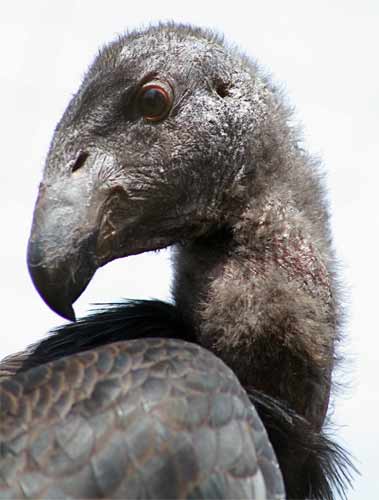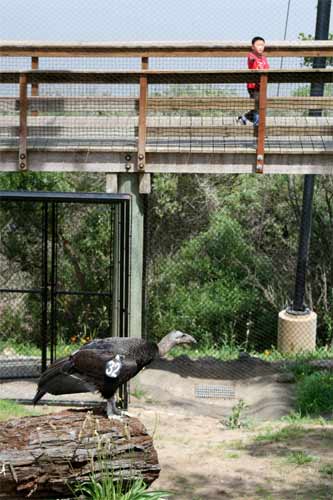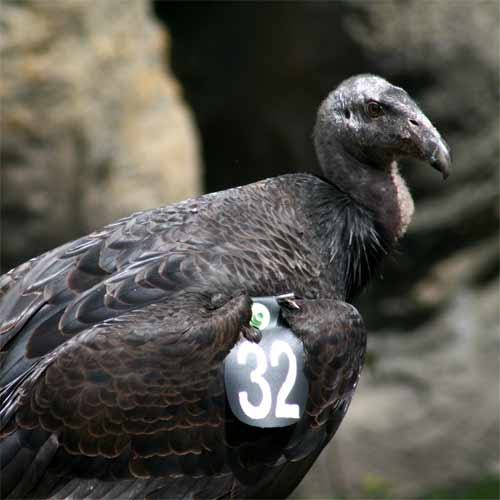Condor Country
A Sneak Preview of Santa Barbara Zoo's Newest Exhibit

The Santa Barbara Zoo is soaring to greater heights.
On April 25, the public is invited to come celebrate the official opening of the zoo’s California Trails exhibit, the centerpiece of which is the recently completed California condor aviary dubbed “Condor Country.” Housing four juvenile condors – don’t let the word “juvenile” fool you, the two-year-old birds already have wingspans of nine-and-a-half feet – the exhibit sits atop a hill overlooking the Santa Ynez Mountain range, which is part of the endangered birds’ natural habitat range.
The new $7.5 million complex, which also showcases a variety of other endangered California species including the Channel Island fox and California desert tortoise, is the largest construction project in the zoo’s nearly 50-year history. And with the addition of the condor aviary, the Santa Barbara Zoo becomes one of only three zoos in the world to display the endangered bird, joining Condor Ridge at the San Diego Wild Animal Park and the Chapultepec Zoo in Mexico City.

While there are no plans to breed the birds during their stay at the Santa Barbara Zoo, their new home was designed and built in collaboration with the Condor Recovery Program. In an effort to continually raise population numbers in the wild and in captivity, the program determines which birds are housed, released, and/or bred.
According to assistant zoo director Alan Varsik, the individual birds in the zoo may change over time but, as of now, the four new additions will act as “ambassadors” to the Zoo and their species. Varsik also explained that housing four condors, who are designated by the Condor Recovery Program as numbers 432, 433, 439, and 440, is a way of freeing up space for facilities that specialize in breeding the endangered animals.
When asked why the Santa Barbara Zoo chose to showcase the iconic birds, Varsik said that the process began over 10 years ago when zoo staff started attending Recovery Program meetings and asking how they could become involved in the revival efforts. In 2002, the zoo officially became partners in the recovery process and began planning the new exhibit, “With their natural habitat in sight, and the zoo’s enthusiasm for the project, it just seemed like a good fit for everybody,” Varsik said.

“It’s great to talk about this unique bird in terms of its size,” continued Varsik, who heads up all zoo animal care and education, “but for me the big thing is what the condor represents: hope. Through the collaboration of many agencies and individuals, the condor was successfully and remarkably brought back from the brink of extinction. If we can continue to save condor habitat range, which is huge, we’ll be saving a lot of other animals and ecosystems as well. And having them here is a way for people to learn about and connect with these amazing birds.” Indeed, the California condor has made an astonishing comeback – numbering only 22 individual birds in 1982, there are now 321 birds alive today with over half flying free in the wild.
The Condor Country inhabitants, all hatched at the Peregrine Fund’s World Center for Birds of Prey in Boise, Idaho, will be able to take advantage of their state-of-the-art enclosure as their wings will remain unclipped, allowing them to fly freely. The exhibit covers over 6,000 square feet and, most importantly, encompasses 174,000 cubic feet of “glide space.” It also houses redwood and oak trees, wood “snags,” and a stream that fills to separate pools; studies have shown that condors often bath and spend hours preening their feathers.
For more information on the April 25 opening, be sure to visit the Santa Barbara Zoo’s website at santabarbarazoo.org/.



